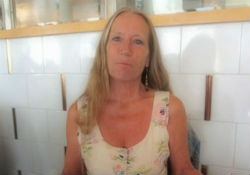Tove, teacher from Sweden

Hepatitis action plan strategic direction 2: interventions for impact
When I was first diagnosed with hepatitis C, I had never even heard of the disease. Looking back, it all makes sense now. I had many different symptoms throughout my life, but they were never serious enough to associate them with a disease and I always tried to find a way to justify them, such as ageing or working too hard. I was diagnosed with genotype 3, and the doctors believe that I had had the disease for over 30 years. Though still unsure, I think I got the disease from a dentist in Nepal who used dirty instruments for my procedure.
I tried to learn as much as I could about my diagnosis on my own. The more I learned, the more it depressed me. It was really difficult and disheartening to see all of my hospital papers with a screaming red label stating “contaminated blood”. Psychologically, knowing that my blood was poisonous was a horror. I was terrified that I might have transmitted my terrible blood disease to my daughter; I could not handle it. The suspense of waiting for my daughter’s blood test was unbearable, but thankfully it was negative.
My treatment process was very complicated. I was over 60 years old, I had thrombocytopenia (low blood platelet count, causing slow blood clotting) and cirrhosis (liver damage), and all of my symptoms were advancing very quickly. I think being diagnosed with cirrhosis was the most difficult part of my process. For me cirrhosis felt like a definite goodbye to my children, adventures and life itself. I was so upset, afraid and sad that I lost my sense of orientation. I could not even find my way around – I constantly felt lost.
One day I met a French professor who told me about a novel treatment, which was used in France. At the time, this was not legal in Sweden, but my doctor was able to enrol me in a clinical research trial. I had to have a special prescription, and could only buy the medication at one pharmacy in a very distant hospital. I was treated for a year, going to the hospital twice a week to get injections and testing. I was taking three different medications, each with terrible side effects. I lost my hearing and have had two corneal transplants, but somehow my fantastic treatment team kept me going. I practically lived at the hospital. Although it was exhausting, having this team supporting me was both reassuring and comforting. The unwavering support from the hospital made the terrible drugs seem not as bad.
I like to think that my participation in the research trial of that medicine has helped save others’ lives. The drug is now accepted as treatment for hepatitis C patients.
I hope that I can help people by telling them what to expect from treatment and where to get help. At the same time there are moments of sadness when I think that if I had had the possibility to have the new drugs on the market today, I might not have lost my hearing and vision. I am mostly trying to adopt an educational view of my experience. I want to tell people to fight for their rights to seek the best treatment and educate themselves about all of the options. They should know how important it is to play an active role in their own healing process. My goal is to work internationally to provide these better conditions for everyone.
To patients currently diagnosed, do not give up because your doctor says you have to wait for treatment. Keep fighting for information and treatment, and seek the best treatment possible. Educate yourself as much as you can about hepatitis. Do not become a victim, and do not feel sorry for yourself. Do not accept defeat or let this disease define you – do something about it! Some of us are luckier than others in regards to access to treatment, but even if you are faced with obstacles, never give up! Contact patient organizations – seek help in different ways, because everyone deserves treatment and to live a healthy life.



